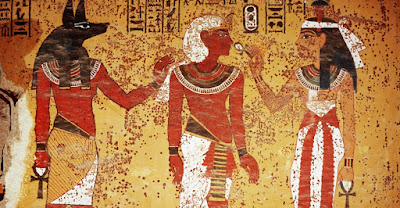A 2D ancient point of view
"A picture is worth a thousand words"! But what about two pictures?
The most intriguing feature of ancient Egyptian
painting and writing is their flatness. For thousands of years the painting and
hieroglyphic dogma was strictly respected as a sacred directive. Actually, this
“2D” style in murals is present all over the world in ancient cultures. Why?
Focusing on
the Egyptians, we might start questioning how this sacred artistic approach was
possible for such a long period in a
very developed society, having advanced geometry and superb architectural
skills!
“Perspective” in art was discovered (or better said-
was used) much later during the Italian Renaissance even if some faint elements
of perspective could also exist in ancient art, as overlapping figures on the
murals in ancient Egypt, scaled painted characters (bigger means closer to the
viewer), ancient Greece etc. But we are still dealing with 2 D graphics.
Sculptures are 3D though! Human eyes were able to see the perspective of
mountains, roads, buildings etc! In this context why is perspective missing in
ancient art?
Cave paintings on the other hand, especially those in France (Lascaux, Chauvet etc) thousands of years older than the established antiquity, show advanced painting techniques and perspective, an almost 3D design!
It looks like a regression in art development, a jump
from the realistic observation and re-creation of the environment to a
dogmatic, flat universe! How could our ancestors lose grip on the 3D
perspective illusion?
Was it just a simple art involution? Maybe some other
factors should be considered.
Egyptian hieroglyphs can be read from left to right,
right to left, top to bottom, etc facing the god to whom the text is referring
to! But this writing is a pure mural depiction. And it is sacred as are the
paintings in temples or tombs. Ancient
Egyptian paintings are the precursors of modern hero comics cartoons, where the
gods are the main characters. These paintings are the ancient Marvel version of
a flat, dogmatic view of sacred reality!
Writing and subsequently painting is a gift from the
gods, in our case from the god Thoth (or Djehuti), one of the most ancient gods
in the Egyptian pantheon! His ibis head is easily recognizable and is associated
with special attributes as “the scribe of the gods”, companion of Ra, etc.
If a bird like creature taught hieroglyphic to the
ancient Egyptians, maybe this is reflected into the writing style itself.
Certain animals, birds and reptiles have monocular view as their eyes are placed on the
sides of their heads. The images are reunited in the brain as one or two images
of the environment. Rattle snakes have thermal receptors that enable them to
create images as thermal night vision .
The Ibis head of the god Thoth will place his eyes on
the far sides of his skull and this fact will be decisive in the formation of
the images in the brain of such a creature. If it was a creature at all and not
a technical device, a robot or an Extraterrestrial Biological Entity .
Modern technology created 360 degrees photo/video cameras with two or
more lenses. The images obtained look strangely similar to what Thoth’s view could
be! In this case we get two 2D different images that even if combined with no
perspective and depth of field attributes, the two images will be flat!
Several experiments should be done, using mirrors too
(mirrors were sacred tools of the gods in ancient Egypt! Why?) Also, this
possible interpretation could be considered during the translation of
hieroglyphs as facing, same story, reunited, depictions.
Other interesting but very faint evidence could lead
to a 2D sacred view of messages in ancient Egypt.
According to ancient stories, the god Horus (another
bird like being) son of Isis and Osiris, lost an eye during the frequent
battles against Seth, the murderer of Osiris. Isis asked Thoth for help in
restoring the complete sight of Horus. The ibis headed god promptly repaired
Horus’s lost eye!
Is the “eye of Horus” a 2D image sensor? Were that
peculiarly drawn texts and murals meant for a 2D vision sighted god, the One-Eyed
Horus being and a high-tech Thoth ibis-headed extraterrestrial?
As usual in the end I will stress that further
out-of-the-box experiments should be the leading engine in ancient technology
research because lots of 2D images could reveal much more than just one thousand
3D words!



















No comments:
Post a Comment
Your comments here: